This article deals with a form of database organization known as OLAP. Before you start reading it, and to make sure you fully grasp its contents, you may be interested to read our article on databases. This article will explain how databases work, their architecture and the different programming languages that govern them.
Databases are becoming increasingly ubiquitous. However, behind this term lie different categories that do not follow the same organizational rules. Whether it’s a relational database or an OLAP database, there are many differences. In this article, you’ll find out everything there is to know about OLAP, a powerful analysis technology.
What is OLAP ?
OLAP; for online analytical processing is a technology for organizing large commercial databases that supports multidimensional analysis.
It can be used to perform complex analytical queries without adversely affecting transactional systems. For example, it is possible to quickly obtain the number of sales and then add other dimensions such as dates, geographical regions or other characteristics of the sale, which would previously have taken a considerable amount of time.
This form of data pre-sorting greatly reduces the time between database query and completion. To better understand what OLAP technology is, and more specifically where the need for such a tool came from, you can watch the following video:
How does OLAP work?
The first step in OLAP’s operation is the collection of data from one or more sources, which is then stored in data warehouses.
Subsequently, OLAP assembles and organizes databases in the form of OLAP cubes, in order to increase the speed of analysis. A cube contains data that is sorted into so-called dimensional tables, the dimensions of which are then filled in by users.
From one or more two-dimensional tables to a multi-dimensional organization
What's the difference with OLTP?

OLTP and OLAP (online transaction processes) don’t carry out queries in the same way. An OLTP query only concerns a small number of records.
A common example of an OLTP query is a bank transfer from one account to another. In such an example, only the sender and receiver accounts are modified. In contrast, an OLAP query tends to mobilize a large amount of data to produce an analysis. To take the example of a company’s sales over 10 months, for 8 products and 6 locations, 480 data items are mobilized, so this number increases rapidly.
What are the advantages of OLAP?
OLAP enables users to gain various insights into a set of data. These include dashboards, reporting and analysis. The best-known analysis techniques enabled by OLAP are as follows:
- Roll-up: this operation consists in gathering data around a cube. This is done either by removing certain dimensions from a cube, or by gathering data together.
- Drill-down: this involves refining the analysis within the data system. For example, if the user wishes to refine his geographical search, he will switch from the “continent” dimension to the “country” dimension.
- Slice: this operation consists in building a new sub-dimension from a particular dimension of another cube.
What are the practical uses of OLAP?
OLAP is commonly used for many data analysis tasks, such as data mining. In other words, this tool makes it possible to explore and analyze certain databases in order to extract trends from the relationships established between the data. This is made possible by the multidimensional data of OLAP systems.
As a result, OLAP is at the heart of many data warehouse tools. It enables data from multiple sources to be brought together for analysis and comparison, which is exactly what data warehousing is all about. OLAP enables data to be converted into usable information.
Thanks to its multiple uses in converting data into useful information and insights, this technology is one of the keys to the emergence of business intelligence. OLAP is at the heart of BI software, as it enables analyses to be carried out based on the company’s acquired and prospective data. For example, one of our partners at DataScientest Microstrategy uses ROLAP, which is a variation of OLAP technology.
The great advantage of an OLAP-configured database is that it enables comparisons to be made between different data that do not necessarily come from the same databases.
To sum up, OLAP is particularly useful for decision-making, as this analysis method provides a wide range of reliable indicators of a company’s performance, but also enables certain forecasting tools to be put in place, notably through the identification of trends.
How do I learn to master database management?
If you’d like to find out more about databases, how they work and what they’re used for, and if you’re professionally interested in this sector, you can learn more by applying for our data engineer training course. This course provides training in a profession whose essence is to guarantee the quality and security of data, but also to decide on the organization of data.










